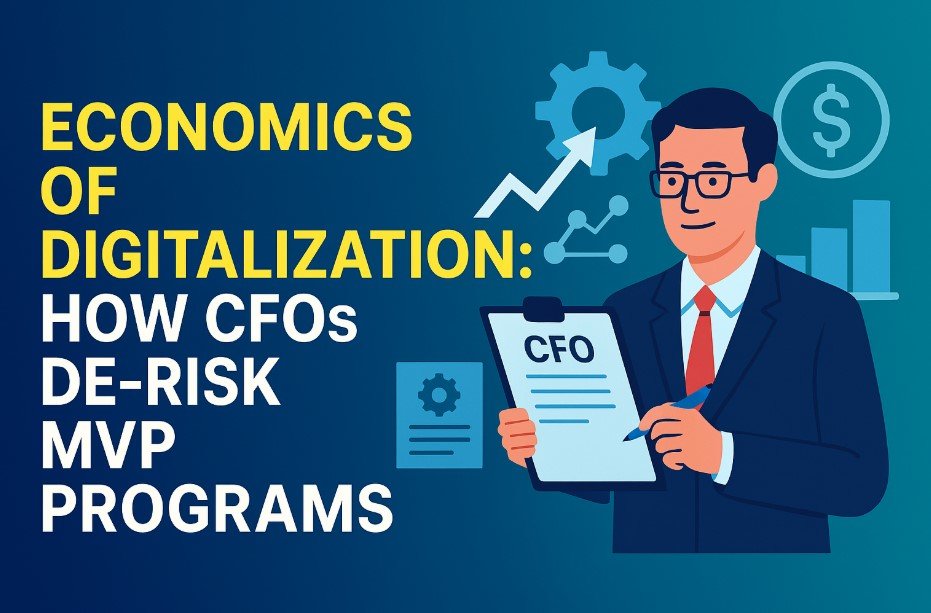Finance
Economics of Digitalization: How CFOs De‑Risk MVP Programs

Digitalization lives or dies on the numbers. Slides don’t pay back; cash flows do. For CFOs, an MVP isn’t a toy project. It’s a controlled bet with capped downside and learnings that point to scale – or to a clean stop. This article breaks down how finance leaders size that bet, cut risk, and keep everyone honest.
TL;DR: treat an MVP like a financial option; set guardrails up front; fund in tranches; measure what moves the P&L; stop early when the math says so.
What Finance actually worries about
Not vanity metrics. Four buckets dominate boardroom questions:
- Cost of delay. Every month without the feature means lost margin, churn, or higher cost to serve.
Rule of thumb: Cost of Delay (per month) = ΔRevenue + ΔGross Margin + ΔAvoided Cost − ΔRisk Cost. - Execution risk. Can the team ship a thin slice on time and keep it stable?
- Compliance exposure. PII, consent, audit trails, vendor risk. Regulators won’t buy excuses.
- Lock‑in and lifetime cost. Today’s shortcuts can become tomorrow’s tax.
Choosing the right partner matters here. Shortlist neutral, referenceable builders who can show migration playbooks, not just designs. If you’re scanning the market, the curated list at digitalization companies is a good starting point to compare approaches.
MVPs as Real Options (not Mini‑Products)
Think like finance. An MVP is the premium you pay to buy information and future upside.
- Premium: the MVP budget and runway.
- Strike price: the scale‑up investment if signals are green.
- Expiry: the date when you stop, pivot, or scale.
This framing keeps debates grounded. No endless scope creep. No sunk‑cost fallacy. The option either gets exercised – or it expires.
Tranche funding works. Release money in three waves tied to evidence:
- Hypothesis tranche (2–4 weeks). Validate demand and feasibility.
- Usage tranche (4–8 weeks). Ship the thin thread, collect real usage, prove unit economics.
- Scale tranche (8–12+ weeks). Only if target signals are hit.
For execution support, many teams bring in focused MVP squads for the first two tranches – design, build, ship, measure, then step back. See scope patterns at MVP development services.
Metrics that actually move the Needle
Keep the list short. Make every metric tie to cash or risk.
- Time‑to‑first‑value (TTFV): median time for a new user to complete the value action (quote issued, claim filed, payment settled). Lower is better.
- Activation rate: % of sign‑ups reaching the value action in 7 days.
- Unit economics per journey:
UE = Avg. Gross Margin per transaction − Variable service cost − Fraud/chargeback allowance. - Cycle time: idea → prod deploy → validated signal. Short cycles cut the cost of delay.
- Stability guardrails: change failure rate, mean time to recover (DORA‑style). Cash hates outages.
- Compliance readiness: audit‑grade logs exist, data map complete, vendor DPIAs done. Pass/fail. No wiggle room.
Post these targets on one page. If a number drifts, the tranche doesn’t unlock. Simple.
Kill Rules: Measure Twice, Cut once
Write your stop conditions before you write code. Then stick to them.
- Red lines (stop): Activation < X% by week 6, or UE negative at target volume, or regulatory gap not fixable in sprint.
- Yellow lines (pivot): Activation flat but TTFV high → cut steps; UE negative due to support calls → redesign flows that trigger tickets.
- Green lines (scale): Activation ≥ target, stable UE, cycle time within band, no open high‑severity risks.
This looks harsh. It’s kinder than burning two more quarters on hope.
Architecture Choices that De‑risk Spend
You don’t need a platform. You need a thin thread users care about, built to evolve.
- Strangler pattern at the edge. Route a single journey (e.g., onboarding) through a new service. Leave the core alone for now.
- Event outbox + CDC. Keep data flowing without dual‑write chaos. Replayable logs beat ad‑hoc scripts.
- Contract tests over point‑to‑point calls. Frozen interfaces reduce surprise bills later.
- One‑click rollbacks and feature flags. Control blast radius. Night deploys stop being scary.
- Privacy by design. Data minimization, short retention by default, deletion flows from day one. Auditor’s notice.
Compliance as a First‑Class Citizen
Regulated or not, act like you are.
- Data map in week 1. What data, where it lives, who touches it, and why it exists. No map, no go.
- Audit logging. Every sensitive action stamped with who/when/what. Immutable store.
- Access by role. Least privilege through policy, not vibes. Quarterly reviews.
- Third‑party risk. DPIAs for vendors; exit plan documented.
This isn’t red tape. It’s insurance you’ll be glad you bought.
Operating Model: keep it small, keep it real
- Lean runway. A small cross‑functional squad beats a cast of thousands.
- Weekly evidence review. Numbers talk. Demos without numbers don’t count.
- Shadow accounting. Track spend vs. value created, weekly. CFOs love clarity.
- Post‑mortems that teach. No blame. Just facts, decisions, and what changes next time.
A Quick Checklist for CFOs
- Cost of delay quantified and published
- Option framing agreed (premium, strike, expiry)
- Tranche gates tied to hard signals
- Thin thread defined; architecture can be undone
- Data map, audit logs, and DPIAs in place
- Kill rules written and signed
- Metrics dashboard live by week 2
- Vendor/partner plan with exit routes
Closing thought
CFOs don’t fear MVPs. They fear undefined bets. Treat digitalization like a portfolio of options, not a leap of faith. Fund evidence, not promises. Cut sooner. Scale only when the numbers say “go.” If you want a reference point for teams that build this way, S‑PRO is a useful benchmark – pragmatic, product‑minded, and focused on outcomes.
-

 Social Media2 months ago
Social Media2 months agoWhat the “67” TikTok Meme Really Means
-

 Tech2 months ago
Tech2 months agoWhat To Do When Your Business Faces Network Vulnerabilities
-

 Self Improvement2 months ago
Self Improvement2 months agoUsing BCBS Rehab to Access Quality Addiction Care
-

 Games2 months ago
Games2 months agoPusoy Strategies for Play That Also Work in Pusoy Dos in English






